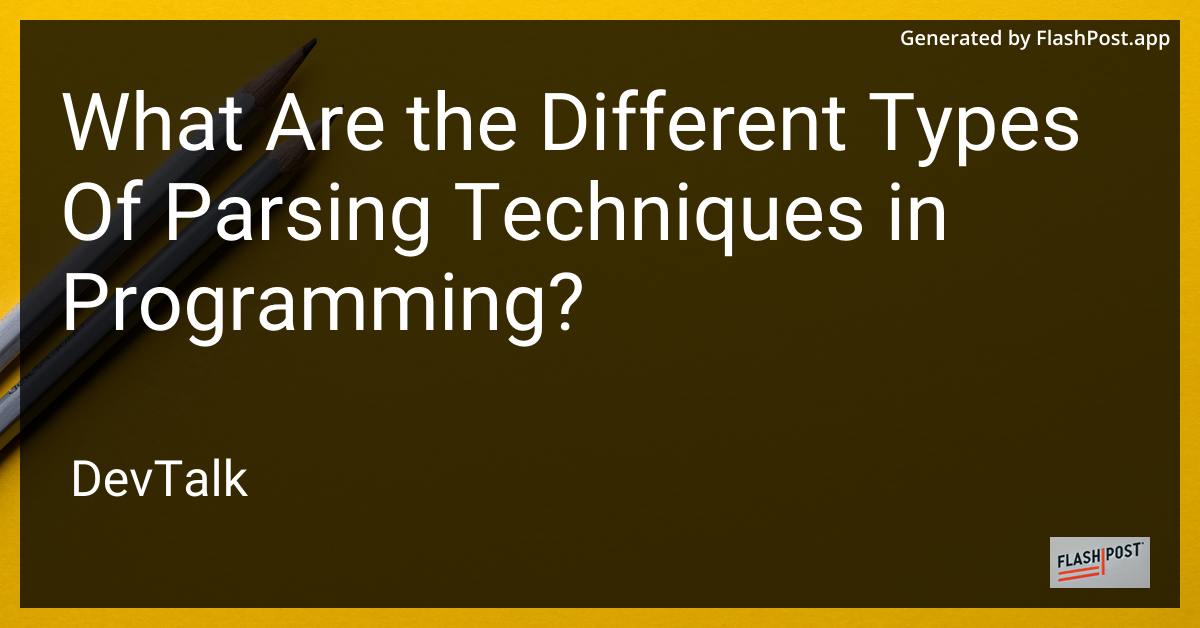What Are the Different Types Of Parsing Techniques in Programming?

Understanding the Different Types of Parsing Techniques in Programming
Parsing is an essential process in computer programming, involving the analysis and conversion of data to a format that can be easily utilized by applications.
This article will explore the various types of parsing techniques commonly used in programming, shedding light on their applications and advantages.
What is Parsing?
Parsing refers to the process of interpreting and converting a sequence of symbols in a source language into a data structure that can be easily manipulated. The resulting structure, often a parse tree or abstract syntax tree (AST), makes it easier to extract information or perform further operations on the input data.
Types of Parsing Techniques
Below are some commonly used parsing techniques in programming, each with unique characteristics and use-cases:
1. Top-Down Parsing
Top-Down Parsing is a strategy where parsing begins at the root of the parse tree and proceeds towards the leaves. The primary types of top-down parsing techniques include:
-
Recursive Descent Parsing: This involves a set of recursive functions to process input. While simple to implement for grammars without left recursion, it can be inefficient for more complex grammars.
-
LL Parsing: A top-down parsing method that reads input from left to right and constructs a leftmost derivation of the sentence. LL parsers are predictive and require a grammar without left recursion or ambiguities.
2. Bottom-Up Parsing
Bottom-Up Parsing constructs the parse tree from the leaves and works its way up to the root. The typical forms of bottom-up parsers are:
-
LR Parsing: Stands for Left-to-right, Rightmost derivation parsing. It’s powerful and handles more grammars than LL parsing. It's often used in compiler construction due to its efficiency in error handling.
-
LALR Parsing: This variant of LR parsing combines lookaheads with LR parsing, providing a more memory-efficient approach.
3. Operator-Precedence Parsing
This type of parsing deals specifically with grammars that define operator precedence. It simplifies handling expressions where operator hierarchy needs to be preserved, such as in arithmetic operations.
4. Earley Parsing
Earley Parsing is suitable for handling all types of context-free grammars. It’s less efficient than other parsers but highly versatile, capable of parsing ambiguous and complex grammars.
5. JSON Parsing
JSON parsing involves converting JSON data into a format usable by a programming language. It's widely used in web technologies for data interchange. Learn more about JSON parsing in Presto or explore some JSON parsing tips for handling complex JSON data structures.
6. Regex Parsing
Regex parsing utilizes regular expressions to match strings and extract data efficiently. A common application is tag parsing with regex in Docker, which is essential for handling tagged strings in many applications.
7. Non-JSON Parsing
Not all data arrives in JSON format. Learning techniques for parsing non-JSON data in FastAPI can be useful for different types of unstructured data.
8. Specialized Parsing
Different domains often require specialized parsing methods. An example is parsing month-year strings using Presto, which demonstrates extracting temporal data efficiently.
Conclusion
Parsing is a foundational skill in programming that facilitates effective data manipulation and expression evaluation. Understanding the different types of parsing techniques can help you choose the appropriate approach for your specific needs, leading to efficient and effective software development.
Whether you are dealing with JSON, regular expressions, or more niche parsing requirements, mastering these techniques can significantly enhance your programming capabilities.
This article provides a comprehensive overview of parsing techniques in programming, ensuring it is both informative and search engine optimized.